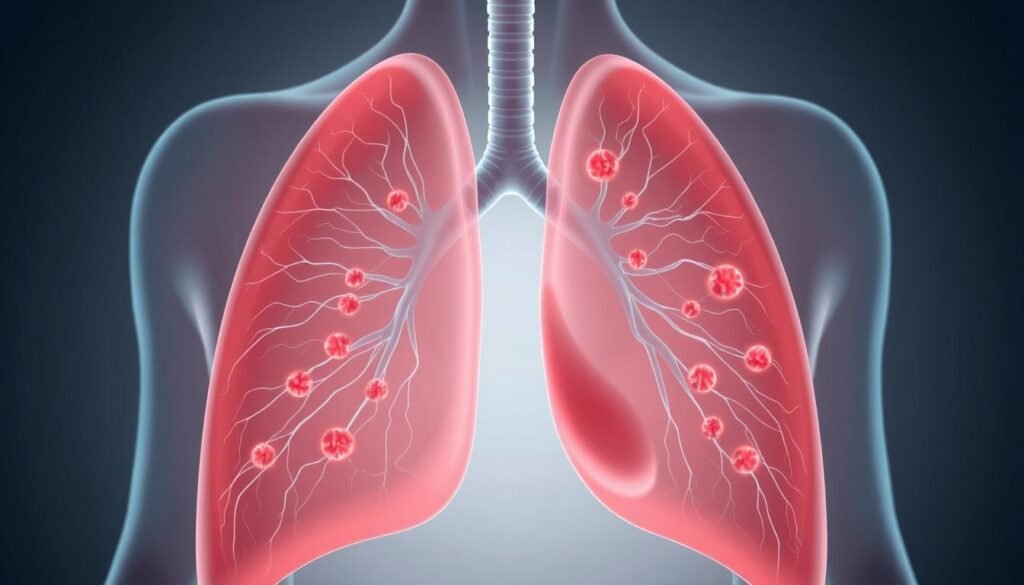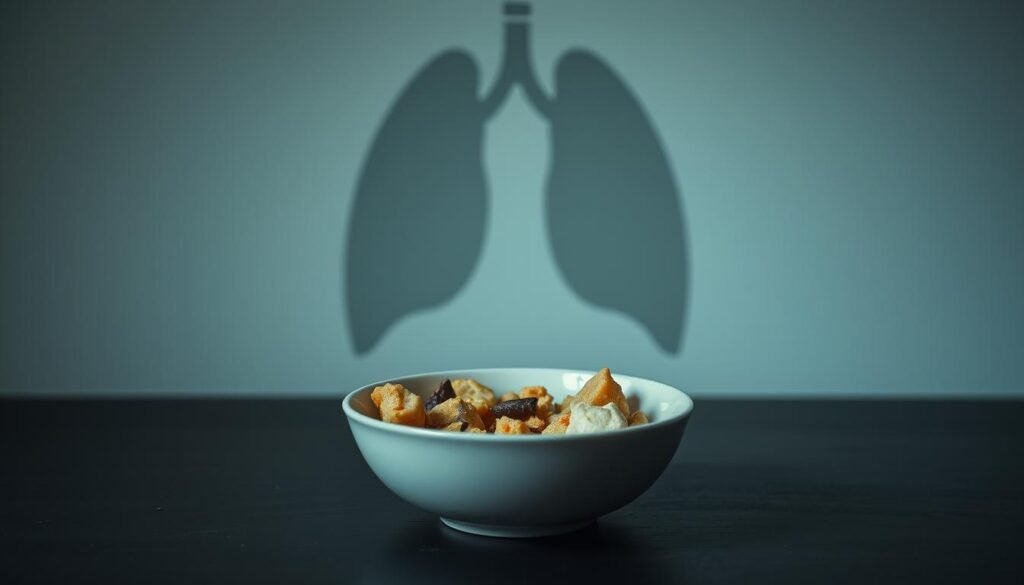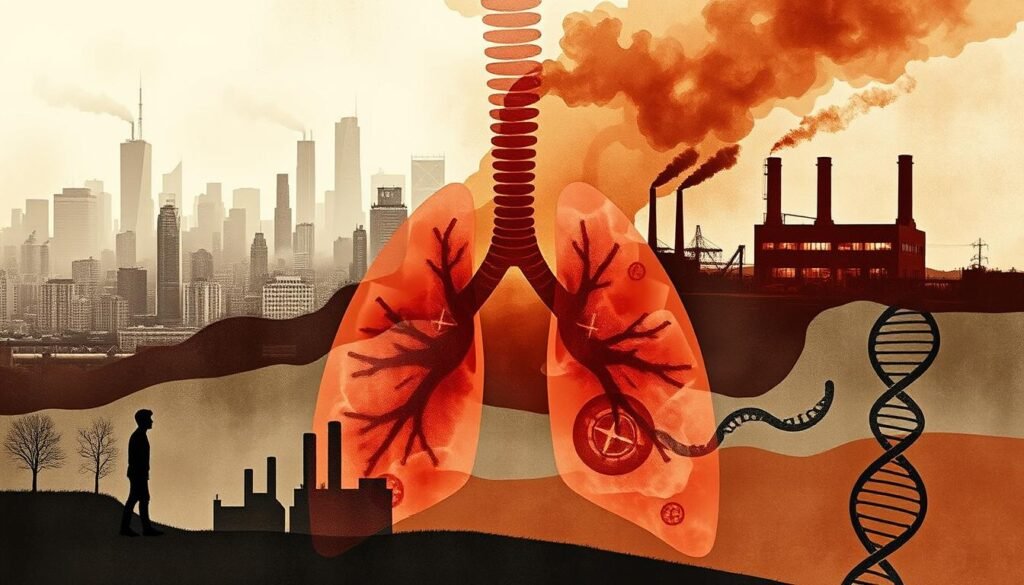About 10% to 20% of lung cancer cases happen in people who have never smoked. This fact highlights the need to know the symptoms of lung cancer in non-smokers. Lung cancer isn’t just a smoker’s disease; it affects non-smokers too. Knowing the symptoms is key for catching it early. This can lead to better treatment results. Many lung cancers don’t show symptoms until they’ve grown. So, being informed can save lives.
Key Takeaways
- Recognizing non smoker lung cancer symptoms can lead to earlier diagnosis.
- Early lung cancer symptoms may not be obvious but require attention.
- Most lung cancer symptoms can also indicate other conditions.
- Common symptoms include persistent cough and chest pain.
- Understanding risk factors can help in proactive health management.
- Consulting a doctor when experiencing symptoms is essential.
Understanding Lung Cancer in Non-Smokers
Lung cancer isn’t just a smoker’s disease. It also affects those who’ve never smoked. About 20,000 to 40,000 new lung cancer cases in non-smokers are found yearly in the U.S. It’s key to know the lung cancer risk factors that hit non-smokers hard.
Adenocarcinoma is the main lung cancer non-smokers get. Being around secondhand smoke ups your risk by 20-30%. Things like asbestos and radon are big dangers too. If you have certain genes or lung diseases, you’re more at risk.
It’s vital to understand non-smoker lung cancer risk factors for prevention. Your age, gender, and health matter a lot. Lung cancer is rare in people under 35. Women and men face different risks. Lung scarring conditions boost your chances a bunch.
Knowing these facts can lead to action against lung cancer in non-smokers. For more, check out this comprehensive study. It dives into how to avoid and treat this big health issue.
Common Symptoms to Watch For
Lung cancer shows some signs that everyone should watch for. Spotting these signs early can help a lot with treatment. Look out for a cough that won’t go away, coughing up blood, and chest pain. Any of these signs need quick action and maybe a doctor’s visit.
Persistent Cough
A persistent cough can last for weeks and get worse over time. If you have a cough that won’t stop, it could be an early warning of lung cancer. It’s different from a normal cough and might mess with your daily life or sleep.
Coughing Up Blood
Coughing up blood or seeing rust-colored spit is a big warning sign. It means you should see a doctor right away. This symptom can point to lung cancer or other serious issues. Getting checked early is key to figuring out the problem.
Chest Pain
Feeling chest pain is a major concern. This pain can get worse when you breathe deeply, cough, or laugh. It might be a dull ache or sharp and intense. If you feel this pain, getting it checked out early is important for lung cancer care.
Early Lung Cancer Symptoms
Spotting early lung cancer symptoms can save lives. People might notice signs indicating lung problems. Symptoms like hoarseness, shortness of breath, and wheezing are crucial. They need immediate medical check-up.
Hoarseness and Loss of Voice
Hoarseness or changes in your voice can signal trouble. It might mean tumors are affecting the vocal cords. Paying attention to how your voice sounds is key.
Shortness of Breath
Struggling to breathe is a sign many overlook. It may be caused by tumors blocking air. Consulting a doctor fast is critical.
Wheezing
Wheezing means your airflow is restricted. It could hint at early lung cancer due to blockages. Catching this sign early leads to quicker action.

Knowing these signs helps people act early. If at risk, get regular checks and watch for odd breath symptoms. For more on lung cancer signs, visit this resource.
Additional Lung Cancer Signs
There are some signs of lung cancer besides the usual breathing issues. These include losing your appetite and weight without trying. These symptoms might mean there are other serious health problems that need a closer look.
Loss of Appetite
When someone doesn’t feel like eating much, it could be a clue. Many lung cancer patients find they don’t want to eat. This change can affect how much nutrition they get. It might also cause more health problems.
Unexplained Weight Loss
Weight loss that happens for no clear reason is worrying. If you’re not trying to lose weight by dieting or exercising more but still do, it could signal a big health concern. This includes lung cancer. Cancer can change the way the body uses energy, leading to weight loss. Spotting this early is key to getting help fast.

Lung Cancer Risk Factors Beyond Smoking
Many factors add to the risk of getting lung cancer in non-smokers. Smoking is well-known, but other risks often get missed. It’s important to know these risks to protect our health.
Secondhand Smoke Exposure
Secondhand smoke is a big risk in the US, even if you don’t smoke. Being around smoke, especially inside, puts you at risk. It’s why pushing for smoke-free places is key.
Environmental Factors
Things in our environment also affect our lung cancer risk. Radon gas is a big one, after smoking, it’s the second leading cause. Houses with high radon levels are very risky. Also, being around asbestos and air pollution can hurt. Sadly, many of us live where the air isn’t clean.
Genetic Predisposition
Our genes can make us more likely to get lung cancer. If lung cancer runs in your family, or if you’ve had it early, your risk goes up. Even without smoking, certain DNA changes increase the risk. Plus, past radiation therapy on the chest adds to this risk.

| Risk Factor | Impact on Lung Cancer Risk |
|---|---|
| Secondhand Smoke Exposure | Increases risk significantly, even for non-smokers. |
| Radon | Second leading cause of lung cancer; responsible for approximately 21,000 deaths annually. |
| Asbestos | Workers exposed are several times more likely to develop lung cancer. |
| Air Pollution | Linked to 1% to 2% of lung cancer deaths; affects those living in unhealthy air quality areas. |
| Genetic History | A personal or family history increases the risk, particularly with early diagnoses. |
Importance of Early Detection
Early detection greatly boosts lung cancer treatment success. It means catching the cancer early, when treatment works best. For those at risk, lung cancer screening is key for finding it early.
Benefits of Early Diagnosis
Spotting lung cancer early has many benefits:
- Increased survival rates: Finding cancer early ups the chances of beating it.
- Less aggressive treatment options: Early detection often means simpler treatments.
- Enhanced quality of life: Early treatment helps manage symptoms, keeping daily life normal.
Regular screening can catch lung cancer early. This gives patients a better shot at quick and effective treatment.
How to Monitor Symptoms
Watching for symptoms helps catch lung cancer early:
- Watch for health changes, like a lasting cough, losing weight without trying, or feeling short of breath.
- Go to regular check-ups and talk to doctors about any new or worsening symptoms.
- Get screened for lung cancer if you’re at risk, like if you’ve smoked or have other risk factors.
Knowing how to spot symptoms is crucial in the battle against lung cancer. Being proactive can find issues early, making treatment easier. Early detection is key for better outcomes.
What to Do If You Experience Symptoms
If you start to notice signs of lung cancer, acting fast is key. This quick action helps with getting the right tests and diagnoses on time. If you’re facing weird breathing issues or ongoing problems, see your doctor immediately.
A healthcare provider will guide you toward the necessary imaging tests. These tests help figure out what’s wrong.
Consulting Your Doctor
Talking to your doctor lets you share your symptoms and risk factors in detail. This chat covers your medical past, any environmental exposures, and lifestyle habits. Your doctor might order X-rays, CT scans, or MRI to find potential problems.
Spotting lung cancer early can hugely impact how well treatment works. So, it’s vital to reach out for medical advice as soon as symptoms pop up.
Getting a Lung Screening
Yearly scans are advised for some, despite the US Preventive Services Task Force’s stance on routine screenings for non-smokers. If you have concerning symptoms, talk to your healthcare pro about getting checked. Especially low-dose CT scans for those at high risk, like people over 50 with a heavy smoking history. Acting quickly upon noticing symptoms can make a big difference in your health.
Understanding Lung Cancer Types
Lung cancer is divided into two groups: non-small cell lung cancer (NSCLC) and small cell lung cancer (SCLC). Most lung cancer, especially in non-smokers, is NSCLC. This category includes several subtypes, with adenocarcinoma being the most common in non-smokers. It tends to grow more slowly, so early detection is key.
On the other hand, SCLC is more rare, making up about 6% to 8% of cases. It grows and spreads quickly, which often means it’s found at a late stage. Knowing the differences between these types is important for the right treatment. For example, lung cancer in non-smokers is usually caused by genetic changes. Luckily, new tests lead to treatments that are more specific and effective.
Understanding these lung cancer types helps patients talk with their doctors about how to treat it. The American Cancer Society has a lot of information on lung cancer types, including how they affect treatment and outlook. For more details, check out Understanding Lung Cancer.